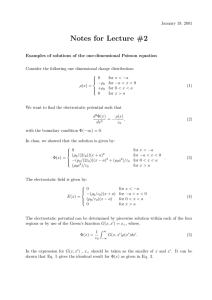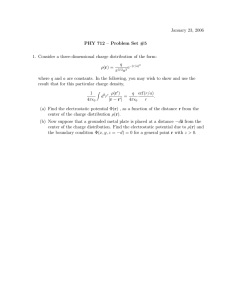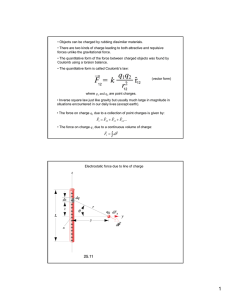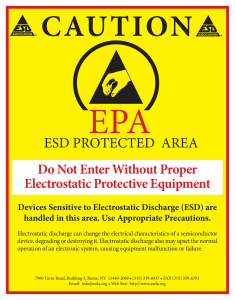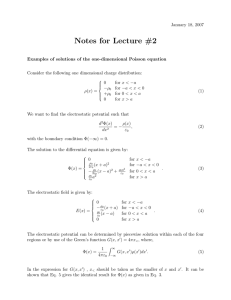Electric Potential and Electric Field Imaging with Applications E. R.
advertisement
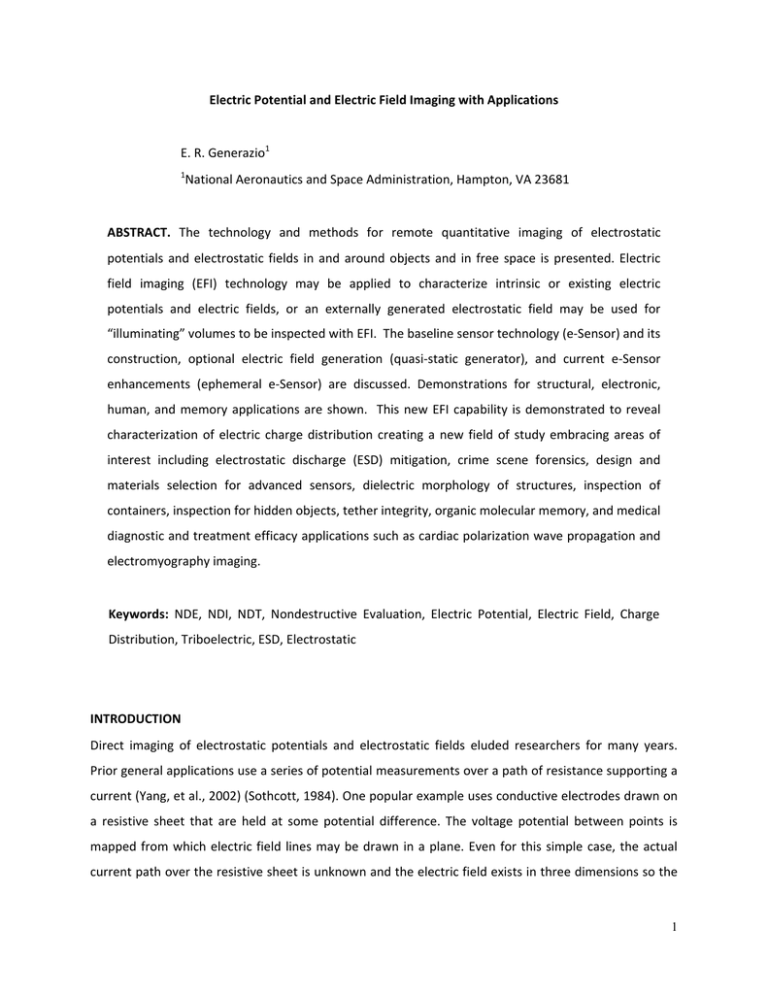
Electric Potential and Electric Field Imaging with Applications E. R. Generazio1 1 National Aeronautics and Space Administration, Hampton, VA 23681 ABSTRACT. The technology and methods for remote quantitative imaging of electrostatic potentials and electrostatic fields in and around objects and in free space is presented. Electric field imaging (EFI) technology may be applied to characterize intrinsic or existing electric potentials and electric fields, or an externally generated electrostatic field may be used for “illuminating” volumes to be inspected with EFI. The baseline sensor technology (e-Sensor) and its construction, optional electric field generation (quasi-static generator), and current e-Sensor enhancements (ephemeral e-Sensor) are discussed. Demonstrations for structural, electronic, human, and memory applications are shown. This new EFI capability is demonstrated to reveal characterization of electric charge distribution creating a new field of study embracing areas of interest including electrostatic discharge (ESD) mitigation, crime scene forensics, design and materials selection for advanced sensors, dielectric morphology of structures, inspection of containers, inspection for hidden objects, tether integrity, organic molecular memory, and medical diagnostic and treatment efficacy applications such as cardiac polarization wave propagation and electromyography imaging. Keywords: NDE, NDI, NDT, Nondestructive Evaluation, Electric Potential, Electric Field, Charge Distribution, Triboelectric, ESD, Electrostatic INTRODUCTION Direct imaging of electrostatic potentials and electrostatic fields eluded researchers for many years. Prior general applications use a series of potential measurements over a path of resistance supporting a current (Yang, et al., 2002) (Sothcott, 1984). One popular example uses conductive electrodes drawn on a resistive sheet that are held at some potential difference. The voltage potential between points is mapped from which electric field lines may be drawn in a plane. Even for this simple case, the actual current path over the resistive sheet is unknown and the electric field exists in three dimensions so the 1 true electrostatic field is not quantified. These methods estimate the apparent resistivity rather than specifying the electrostatic field. A basic problem when attempting to image electrostatic fields is that the measurement sensor is comprised of materials that distort the electric field to be measured. Dielectric, conductive, semiconductive, insulating, and triboelectric materials all distort the original true electric field to be measured. Zahn (Zahn, 1994) discusses the complexities of measuring scalar potentials and electric fields, and provides an optical method based on optical phase shift for determining electric field distributions. Researchers (Blum, 2012), (Hassanzadeh, et al., 1990), (Dower, 1995) have demonstrated quantitative methods to measure electronic signatures of electrostatic fields. However, measurement of the electronic signature is not a quantitative metric of the true electric field so correlations are made to identify objects of interest, etc. Inaccuracies in prior measurements arose due to the lack in attention to details describing the construction of the sensor, the electronic components, and the supporting structures. This work describes methods to measure the electrostatic potential and electrostatic field emanating from an object or existing in free space using the electric field sensor design described by (Generazio, 2011). Subsequent work (Generazio, 2013) (National Aeronautics and Space Administration (NASA), 2014) describes the construction of a quasi-static (Melcher, 1981) electric field generator that “illuminates” large volumes with a uniform electrostatic field. Specifically, these two inventions allow for the quantitative determination of the true metric of the electrostatic field emanating from or passing through or around objects and volumes. The inventions provide quantitative metrics of the electrostatic potential, the electrostatic field strength, the spatial direction of the electrostatic field, and the spatial components of the electrostatic field. e-Sensor Circuit Challenges A field effect transistor (FET) based electric field sensor is described (Generazio, 2011) that uses a nonspecified FET configuration. That is, a FET based electric field sensor circuit that uses a floating gate configuration, which is contrary to all good circuit designs. Good circuit designs that use FETs require a properly supported, but small, electrical current to exist in the gate in order for the FET to function per manufacturer’s specifications. There are three basic electronic FET configurations: common source, common drain, and common gate. FETs may be calibrated for common source and common drain 2 configurations where the gate is physically connected to a voltage source. In the common gate configuration, the gate is physically connected to ground. In all configurations, the electrical connections to the gate are at an electrical potential that is a direct physical electrical path for charged carriers. The electric field sensor described here does not provide the required physical connection for the specified gate current. When a FET is used in a floating gate configuration, gain stability difficulties arise that inhibit calibration. Floating gate based designs require unique calibration protocols. Two aspects to this calibration are the voltage gain and time response of the electric field sensor circuit in the presence of a non-direct static and quasi-static electric potential. The manufacturing tolerance of FET characteristics is well known (Horowitz, et al., 1989) making uniform calibration of multiple FET floating gate based sensors for array based configurations even more challenging. e-Sensor Construction Figure 1 shows the basic e-Sensor circuit elements. Other floating gate based circuits may be used. In addition to the electronic elements of the circuit, attention must be giving to all materials used in the construction of the sensor for the production of a useful measurement system. We want to avoid the occurrence of all surface charges (bound and free) and image charges near the sensing gate of the FET, the electronic connections, and supporting structures. The e-Sensor components are to be triboelectrically neutral, have low electric susceptibility, and non-conducting to minimize sensor distortions of the true electric field due to charging, dielectric polarization, and free carrier polarization. Further details of e-Sensor design are available elsewhere (Generazio, 2011). Figure 2 shows the measurement response of a 16 element e-Sensor array. Note that the measurement voltage is not the electrostatic potential. The electrostatic potential is obtained via calibration and calibration parameters vary for each e-Sensor. In practice, all e-Sensors are calibrated before every scan by generating a slowly oscillating uniform potential across the e-Sensor array. Typical electrical potentials measured are a few volts with a noise level of ±5 mV yielding high signal to noise ratios that exceed 700. Here the electrostatic potential at the e-Sensor gates is being slowly varied at a 2 Hz rate by a remote rotating electrostatic dipole (Generazio, 2013). If the potential is held fixed at any point in time, the measured potential at the e-Sensor slowly drifts to an e-Sensor equilibrium voltage. Each eSensor has a different equilibrium voltage and each e-Sensor has a different characteristic time to reach 3 an equilibrium voltage. Typical times to reach equilibrium are a few seconds. It is important to note here that the equilibrium potential value is independent of any external potential on the floating gate. The equilibrium potential for the top most signal in Figure 2 is shown. The effect of leakage currents may be recognized by the non-sinusoidal potential response at the peaks of the e-Sensor outputs. Each peak shape is different where some are rounded and others are flattened or sloped. These slight variations are due to leakage currents making calibration efforts challenging. The origin of this effect is broadly described to be charging of the gate of the FET due to leakage currents. A more detailed discussion on leakage effects requires an evaluation of parasitic capacitances, inductances, resistances of the entire e-Sensor and structural support system. It is defined here that the terms “effects due to leakage currents” will refer to all effects related to intrinsic electronic properties including leakage of free carriers across electronically insulated boundaries, free carrier build-up, free carrier charging, and all parasitic capacitances, inductances, and impedances. Intrinsic will refer to dimensionally changing volumes of coverage. The volume of coverage starts at the solid state level, goes through the solid state mounting to reach the support structure levels, and advances to describe an electrostatic potential and field sensor for general applications. For example, the structural supports of the solid state elements have dielectric properties and therefore have intrinsic parasitic capacitance, similarly for the structural support of the structure supporting the solid state element, etc. Figure 1. Schematic diagram of an array of e-Sensor circuit elements. 4 Figure 2. Example measured output from 16 e-Sensors in the presences of a reference quasi-static electric field. The quasi-static electric field generator is designed (Generazio, 2013) to provide a controlled source or reference quasi-static electric field for "illumination of objects and volumes" and to reverse and minimize the effects of sensor and support structure parasitic leakage currents. At a quasi-static frequency of 3 Hz, the minimization is adequate so that gain is controlled and the calibration of gain of the electric field sensor in a quasi-static electric field is straightforward. The quasi-static frequency range will be defined below. Only the salient features of the generator (Generazio, 2013) are discussed here. The generator consists of a rotating electrostatic dipole (Figure 3) to generate a slowly varying electrostatic potential. The dipole is charged using a triboelectric process similar to a Van de Graff generator. The dipole charging system is battery powered and wirelessly controlled. All power, wireless receiver, and speed controllers 5 are contained within the structure of the dipole element. A dry wood construction approach is used to maintain the uniformity of the electric field in the vicinity of the dipole. Wood having neutral triboelectric affinity and low dielectric properties is used to limit stray charging and polarization of the structure of the generator and for the rotational support of the dipole. A large conducting plate (see Figure 4) is used to establish an equipotential surface and uniform electrostatic field when used in a near field approximation configuration. The dipole is rotated by a computer controlled stepper motor at quasi-static frequencies to provide a slowly varying uniform electrostatic field. Other approaches may also be used to generate an electrostatic field. However, the approach described here is human safe operating at 100,000 volts while providing only microamperes of current and is isolated from building power supply systems. Figure 3. Photograph of the rotating quasi-static dipole element. 6 A definition of quasi-static is provided here. The quasi-static frequency range is defined where the electric field is present at the gate electrode of the FET for a sufficiently long enough time for the electric field sensor response to reach a steady state for potential measurement, but not long enough for intrinsic and extrinsic leakage or oscillating currents to dominate the measurement of the true static potential. In the defined quasi-static frequency range, accurate metric measurements of the true static potentials are made from which the true static electric field is obtained. Electric Field Imaging (EFI) System The electric field imaging system configuration for inspections is shown in Figure 4. In this configuration, the object being inspected is moved, via a conveyor, to pass between the quasi-static generator and a linear array of e-Sensors. During movement of the object, the dipole may be rotating at any desired rotation speed. Speeds below the quasi-static range may be used to explore leakage effects of material and structural configurations. Speeds just above the quasi-static range are extremely low frequency (ELF) electromagnetic waves (International Telecommunications Union, 2000). ELF and higher frequencies exhibit radiative electromagnetic propagation effects that need to be included in the analysis. Data acquisition of the e-Sensor response may be performed when a preselected voltage, Vsurface, occurs on the conducting surface, or throughout the cycle of the dipole rotation. Data acquired at a preselected voltage corresponds to a constant interrogation electric field strength. Data acquired during the rotational period of the dipole corresponds to a varying interrogating electric field magnitude. For the image data shown here, the potential data is acquired at the times when the dipole is at the same orientation so that Vsurface is at a constant value during measurements. The orientation at data acquisition corresponds to the voltage minimums shown in Figure 2. A 914 mm long vertical linear array of 192 e-Sensors placed 457 mm from the conducting plate of the quasi-static generator providing a uniform electric field. Plates having dimensions of 60.96 cm x 121.92 cm and 121.92 cm x 243.84 cm are adequate to generate uniform electric fields of the inspection region. During inspection the object at a fixed position along the z-axis is moved by the conveyor along the xaxis. The acquired data from the e-Sensor array oriented along the y-axis may be processed (Generazio, 2011) to generate images of the electric field from the object being inspected. The e-Sensor array may be moved along the z-axis by computer control. Data obtained with the e-Sensor array at two or more positions along the z-axis provides sufficient information to generate images of the electric field. Each scan measures the electrostatic potential in the x-y plane to generate an electrostatic potential image. 7 Electric field image reconstructions are produced using the electrostatic potential images. Many other scanning and e-Sensor array configurations are possible. Uniform Electric Field, E (Infinite plate approximation) Figure 4. Diagram of the setup for the electric field imaging (EFI) system. The EFI systems consists of a linear array of e-Sensors, a quasi-static field generator, a conveyor, a data acquisition and image processing, and an object to be inspected. 8 Examples of EFI Images Human in a Uniform Electrostatic Field Figure 5a shows the electrostatic potential of a human in a uniform electrostatic field. The image linear gray scale represents the electrostatic potential ranges from 0 volts (dark shade) to -3.75 volts (light shade). This is one of the first images obtained with the EFI system. It was originally thought that the dipole would need to be constantly triboelectrically charged to maintain a constant potential on the electrodes of the dipole. The effect of that constant charging is shown as vertical banding in this image. It is now known that, for this structural design, the dipole will hold a constant charge for several hours so constant charging is not needed and these vertical bands do not appear in subsequent images. The horizontal lines are due to variations in the individual e-Sensor responses’ that are not fully removed by calibration procedures. The sensor to sensor variations are due to residual gate charging, and work to address this charging has led to the development of a more accurate ephemeral e-Sensor that will be presented later. A commercially available graphic filter is applied to the potential data (Figure 5a) and reveals (Figure 5b) a striking amount of information suggesting the presence of straight cut cotton shirt, cotton pants, legs, pants, and stretch (containing polymer materials) socks. The graphic filter routine highlights image intensity and intensity gradients and is not meant to be representative of an electric field image. Figure 5a is presented here as the first image obtained showing the electrostatic potential of a human in a uniform electrostatic field. A detailed physics based imaging processing procedure was developed and subsequently used for the data to follow. 9 (a) (b) Figure 5. (a) The electrical potential image of a human in a uniform electric field. (b) A commercially available graphics filter applied to the potential data shown in (a). Hybrid Composite in a Uniform Electrostatic Field The electric potential of a hybrid composite compression test specimen (Figure 6a) is shown in Figure 6b. The test specimen has top and bottom support brackets and has a 3.0 cm thick crushed metallic honeycomb core and cracked and buckled composite face plates. The EFI system reveals that the test sample is redirecting the uniform electric field to change the original uniform electrostatic potential (light grey shade in the upper edge of Figure 6b) so that electric potential is raised (dark shade) in the free space around the test specimen. In literal contrast, the electric potential is raised (darker shade) over the test object with some decreased (lighter shade) potential variations existing horizontally across the central region of the test specimen. The top and bottom support brackets have the largest decrement in electrical potential (light shade). The image has a linear gray scale representing the electrostatic potential ranges from 0.0 volts (dark shade) to -3.73 volts (light shade). Polarization of the 10 specimen is also revealed as decrements (light shades in Figure 6b) and increments (dark shades in Figure 6b). The three dimensional graphical representations (Figure 6c and 6d) of the grey scale plot of electrical potential (Figure 6b) highlights how the object distorts the equipotential in which it is placed. The large horizontal bands represent the electrical potential of the upper and lower specimen brackets. Figure 6d shows the three dimensional representation of the electric potential as viewed at a 45 degree angle. specimen bracket discontinuity discontinuity (a) (b) (c) (d) Figure 6. (a) Hybrid composite compression test specimen. (b) The electrical potential of a hybrid composite in a uniform electric field. (c) and (d) are three dimensional graphical representations of the grey scale plot of electrical potential in (b). Electrostatic Field Imaging The generation of electric field images from the electrostatic potential data is described. The electrostatic potentials of the hybrid composite test specimen at two different z-axis locations spaced 1 cm apart (labelled near and away from the e-Sensor array) are shown on the left hand side of Figure 7. 11 The electric field, , and electric field spatial components , , and are obtained using the relation ( , , ) ( , , ) = −∇ ( , , ) = − ( , , ) ̂+ ( , , ) ̂+ (1) whereV(X, Y, Z) is the measured electrostatic potential with x, y, and z coordinates, and ̂, ̂, and are unit vectors in the x, y, and z directions, respectively. Equation (1) is approximated for any point , , , ( , , )≈− ( , , ) ( , , ) ̂+ ( , , ) ( , , ) ̂+ ( , , ) ( , , ) (2) It is instructive to show images of the electric field components as an interim analysis step in Figure 7. Figure 7 shows plots on a grey scale of the components of the electric field along the x, y, and z directions. The y-component of the electric field exhibits discrete horizontal banding that crosses the entire image and is due to the incomplete sensor-to-sensor calibration that is made more apparent by the approximation of the equation. The electric field is given by the vector sum of the components, = + + and has an electric field magnitude shown in Figure 7. The electrostatic field magnitude positive image has a linear gray scale and ranges from 0 volts/cm (dark shade) to 2.275 volts/cm (light shade). The positive and inverse labels in Figure 7 refer to the image reproduction for display visualization. We see from the electric field magnitude positive image in Figure 7 that there are high electrostatic fields (light shade) present at the perimeter of the test specimen brackets as well as in the area between the brackets. The black areas of the electrostatic field magnitude positive image represent low electrostatic field intensity, there remains an electrostatic potential in these areas, but the electrostatic gradients are minimal. High electrostatic fields are expected to occur at potential arcing sites. 12 discon ntinuities Figure 7. The electric potential p of a hybrid comp posite specim men in a unifo orm electric field. The poteentials t specimenn. Images of the x, y, and d z components of are measured at two different disttances from the ude are show wn. the electrric field and of the electric field magnitu I Circuit Compon Insulated Connection Cabling and Integrated nent in a Uniiform Electrostatic Field E capabilityy on other syystems to shoow the utilityy in other ap pplications an nd for Next we explore the EFI nts is well kn nown, guidance in sensor designs. The effect of caabling and shhielding on measuremen on is paid to the t effect on sensor capabbility. The eleectrostatic po otential distortions however, little attentio ding is of a coax cable and an integrated ciircuit are shown in Figure 8a. The rangge of linear grray scale shad F 8. Both h of these staandard circuitt componentss dramatically distort elecctrostatic fields for listed in Figure large distaances. The caable increases the electrosstatic potentiial while the iintegrated cirrcuit decreasees the electrostaatic potential. A comparison of insulation mateerials is sho own in Figure 8b, wherre an unground ded #38 magn net wire does not distort the applied electrostatic potential, V0, to a measu urable amount. In I contrast, polyvinyl p chloride, cotton, rayon, and ppolyethylene all produce ssignificant changes in the pottential. The apparent shaading in this image is duee to surface ccharge on thee insulation d due to 13 handling and will be discussed later. When developing advanced remote sensors, e.g., those to be used in medical applications, the impact of all the components of the sensor needs to be addressed. a. (a) (b) Figure 8. (a) Electrostatic potential image of a coax cable and integrated circuit in a uniform electric field. (b) Electric potential image of a wire, having different insulation materials, in a uniform electric field. 14 Construction Materials in a Uniform Electrostatic Field Electrostatic discharge (ESD) is a well know field and there is substantial industrial investments in addressing and mitigating ESD issues in manufacturing and product use. Electrostatic potential images generated by EFI of selected materials are shown in Figure 9 along with the companion dielectric constants and triboelectric affinities. The upper image in Figure 9 shows the electrostatic potential image for 25.4 mm diameter as received rods of different materials. Here again the strong effect that conducting materials have on the electrostatic potential is recognized by the increase in potential (large dark shaded area on the right side of the image) near the copper rod. The linear grey scale ranges from 0.0 volts (dark shade) to -4.79 volts (light shade). The effect is so strong that the other rods are embedded in an electrostatic potential modified by the copper rod. The same rods were brushed once with a silk cloth. The lower electrostatic potential image in Figure 9 shows the electrostatic potential image for the rods after being brushed by the silk cloth. Here the Polytetrafluoroethylene (PTFE), acrylic, nylon, and polyester rods are charged by the triboelectric interaction with the silk cloth. The triboelectric charging is of sufficient magnitude that the resulting electrostatic potential saturates the e-Sensors. The charged gates of the e-Sensors recover slowly during the scan and leave a record of this recovery by producing both an increased potential (dark shadow) and decreased potential (light shadow) adjacent to the affected rods. Similar shadowing is observed in Figure 8b. Figure 9. The upper image is an electric potential image of solid rods of different materials in a uniform electric field. The materials shown cover a wide range of dielectric constants and triboelectric affinities. The lower image is an electric potential image of same solid rods after being brushed once with a silk cloth. 15 EFI for the development of Organic Memory The above results are quite interesting where it is observed that the triboelectric charges on the rods lingered for long periods of time. PTFE had the largest magnitude charge on the potential field as expected since PTFE has the largest triboelectric affinity. During the set-up of the rod sample set, it was noticed that the PTFE rod had a bright spot (decreased electrostatic potential) on the top on the rod’s electrostatic potential image. Given the observed long latency or memory times of charges on PTFE, it became clear that the previously bright spot on the PTFE rod was from triboelectric charging, which occurred during handling and placement of the rod into the sample holder. A memory storage device was constructed by mounting a PTFE panel in a wooden frame (Figure 10a). The letters “NASA” were drawn on the surface of the PTFE panel with a finger. The EFI potential image is shown in Figure 10a. The letters of NASA are made visible. The last “A” had a large magnitude potential and almost fully saturated the e-Sensors. Several methods were used to “erase” the charges from the panel, however, in a comic moment the author found himself generating double and triple exposures over the same original writing. This image demonstrates that EFI is useful in characterizing charge distribution and EFI may also be used to monitor changes in charge distribution. This memory storage approach is an area of study that is opposite of that addressed for ESD. EFI methodology is able to measure the electric potential from charges that are subsurface and not on the exposed surface being imaged by the e-Sensor. The electrical potential of the letter “N” triboelectrically hand-drawn, by using a finger on a polymer sheet is shown in Figure 10b. The drawing of the letter “N” leaves residual induced charges on the surface drawn. There are two “N” letters shown in Figure 10b. One letter “N” is drawn on the upper half of the front surface and the second letter “N” is drawn on the lower half of the back subsurface of the polymer sheet. The electrical potential image reveals both the “N” letters on the front and back sides of the polymer sheet. This is an important result. Even though there are no triboelectric surface charges on the front lower half of the polymer sheet, an image of the electrical potential of the letter “N” on the back surface is clearly observed. That is, subsurface charges may exist, and their electrical potential measured by both single and double sided EFI, even when the surface exposed to the e-Sensor is uncharged. The capability of EFI to characterize subsurface electric potential variations has important implications. Figure 10c shows an optical image of an acrylonitrile butadiene styrene (ABS) gun simulator in container. 16 The ABS gun simulator has no conducting metallic content or conducting components. The ABS gun simulator is packed, using typical foam packing materials, in a non-conducting container. The EFI electrical potential image is shown as a grey scale plot overlaid onto the optical image of the container. The gun simulator is identified in the electrical potential image (Figure 10c). The body and the barrel of the gun are clearly discernable. The simple act of packing the gun simulator changes the electrical potential of the gun for an extended period of time. The EFI shown in Figure 10c was obtained 24 hours after packing. Subsequent modifications to the e-sensor design have removed the shadowing due to saturated charging and leakage effects. The modified e-Sensor functions in an ephemeral mode (Generazio, 2015). The difference between the e-Sensor and the ephemeral e-Sensor is that the ephemeral e-Sensor is intrinsically forced to return to an uncharged state between measurements. The construction of an ephemeral e-Sensor has been described in detail (Generazio, 2015). Preliminary data from an ephemeral electric field sensor are presented here. Figure 10d shows the electrostatic potential, measured simultaneously by both an e-Sensor and an ephemeral e-Sensor, of a cylindrically symmetric object that has been charged to saturate the e-Sensor. Effects due to leakage currents are absent in the potential measurements from the ephemeral e-Sensor. A solid state ephemeral e-Sensor (Generazio, 2014) has been developed for enhanced single sided measurements. Forensic evaluations of surfaces may be performed using ephemeral e-Sensors. The electric potential of an office rug changes with footfalls. Figure 10e shows electrical potential plots on a grey scale due to residual charges left by footsteps on an anti-static rug. The rug potential varies by 4.46 volts (lightest shade in Figure 10e) after being walked on. The individual left and right footsteps are clearly identified indicating the travel direction as well as the manufactured tread patterns on the bottom of the shoes. Footfall imaging has been done up to 30 minutes after travel. However, it is expected that undisturbed paths may be imaged days later depending on the materials in contact. Footfalls are only one example of forensic interest, and other forensic applications are possible. Future work in this area is needed to establish the residual charge distribution as a function of time. 17 (a) (b) Figure 10. (a) Photograph of the setup for evaluating the memory storage capability of organic polymers. Triboelectrically draw letters of “NASA” are revealed in the electric potential image. (b) The electrical potential of the letter “N” triboelectrically hand-drawn, on two sides on a polymer sheet (c) Optical and electric potential image of an acrylonitrile butadiene styrene (ABS) gun simulator in a container. (d) Electrostatic potential measured simultaneously by both an e-Sensor and an ephemeral e- 18 Sensor of a cylindrically symmetric object charged to saturate the e-Sensor. (e) Forensic electric potential image of footfalls on a rug. c. (c) (c) (d) (d) Figure 10. Continued 19 (e) e. Figure 10. Concluded SUMMARY It is important to summarize the above results to form a complete picture of what is learned. The construction of an electric field sensor (e-Sensor) system that provides a true metric of the electric potential needed for the generation of electrostatic potential and electrostatic field images (EFI) is presented. The construction materials of the EFI system are critical. Attention must be given to the dielectric, triboelectric, and conductivity properties of all elements used in the EFI system where low dielectric, neutral triboelectric, and non-conductive materials are required. A slowly varying electrostatic reference field may be used to reverse and minimize effects of floating gate charging of the FET and leakage currents to facilitate accurate measurements and to provide a very useful “illumination source” for the inspection of objects and volumes. EFI images reveal the topological nature of electric potentials and a demonstration on locating areas with high electric field magnitudes is provided. EFI images of selected materials provide guidance on materials selection for sensor applications including circuitry, wiring, and structural support systems. EFI imaging of humans is demonstrated and EFI technology is demonstrated showing the feasibility of molecular memory storage. EFI capability extends to subsurface imaging for container inspections and 20 for imaging of hidden objects. Data from an ephemeral e-Sensor has been presented highlighting the ephemeral e-Sensor’s ability to minimize effects due to charging and leakage. This new EFI capability is demonstrated to reveal characterization of electric charge distribution creating a new field of study embracing areas of interest including electrostatic discharge (ESD) mitigation, crime scene forensics, design and materials selection for advanced sensors, dielectric morphology of structures, inspection of containers, inspection for hidden objects, tether integrity, organic molecular memory, and medical diagnostic and treatment efficacy applications such as cardiac polarization wave propagation and electromyography imaging. 21 REFERENCES Bibliography Blum D. W. Electric Field Signature Detection [Journal]. - Alexandria : United States Patent and Trademark Office, April 19, 2012. - US 2012/0092019 A1. Dower Roger G. Apparatus for electrostatically imaging the surface of an object located nearby [Journal]. - Alexandria : United States Patent and Trademark Office, July 4, 1995. - US 5430381 A. Generazio Edward R. Electric Field Quantitative Measurement System and Method [Journal]. Alexandria : United States Patent and Trademark Office, February 4, 2011. - US 13/020,025 : Vol. US 20120199755 A1. Generazio Edward R. Ephemeral Electric Potential and Electric Field Sensor [Journal]. - [s.l.] : United States Patent and Trademark Office, May 21, 2015. - US-2015-0137825-A1. Generazio Edward R. Quasi-Static Electric Field Generator [Journal]. - [s.l.] : United States Patent and Trademark Office, March 13, 2013. - US 13/800,379, patent pending. Generazio Edward R. Solid State Ephemeral Electric Potenial and Electric Field Sensor - ergFET [Journal]. - [s.l.] : LAR-18484-1, patent disclosed, March 03, 2014. Hassanzadeh Reza [et al.] Electrostatic Field Gradient Sensor [Journal]. - Alexandria : United States Patent and Trademark Office, June 5, 1990. - US 4931740 A. Horowitz Paul and Hill Winfield The Art of Electronics, 2nd Ed [Book Section]. - Cambridge, United Kingdom : Cambridge University Press, 1989. International Telecommunications Union Nomenclature of the Frequency and Wavelength Bands Used in Telecommunications [Journal]. - [s.l.] : International Telecommunications Union, 2000. - Vols. Rec. ITU-R V.431-7. Melcher James R. Continuim Electromechanics [Book]. - Cambridge : The MIT Press, 1981. - p. 1.4. National Aeronautics and Space Administration (NASA) Quasi-Static Electric Field Generator [Journal] // NASA Tech Briefs / ed. Selinsky Ted. - New York : Tech Briefs Media Group, November 1, 2014. - LAR18204-1. Sothcott Peter Buried Object Location [Journal]. - [s.l.] : Great Britian, July 4, 1984. - GB 2132357. Yang Ying Ping and Macnae James An Apparatus and Method for Detecting an Object in a Medium [Journal]. - Australian Capital Territory : World Intellectual Property Organization, August 29, 2002. - WO 02/067015 A1. 22 Zahn Markus Transform relationship between Kerr-effect optical phase shift and non-uniform electric field distributions [Journal] // IEEE TRansactions on Dielectrics and Electrical Insulation. - April 1994. No. 2 : Vol. 1. - pp. 235-246. 23
